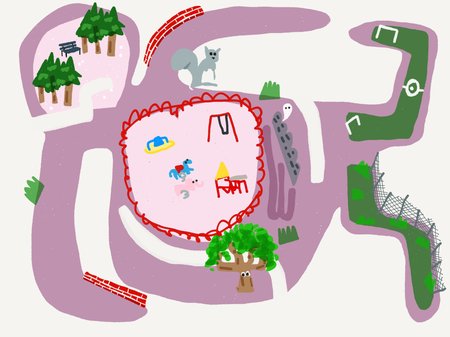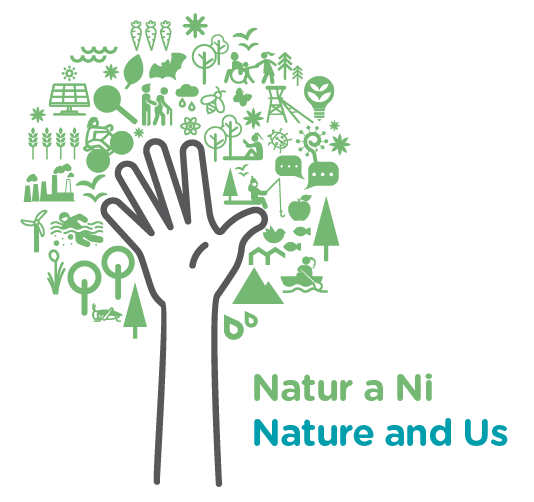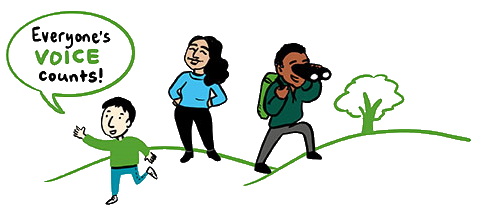Justin Teddy Cliffe

Justin is a theatre maker and artist based in Newport. He creates absurdist, comedic and raucous work that explores human experience, mental health and pop-philosophy through a contemporary kind of low-brow clowning. Justin’s residency took place in a small parkland close to where he lives. He wanted to explore this place because it feels like it belongs to him but that he shares it with other people. He set up residence in the par to explore communality and, through acknowledging it, power, value, ownership and trust.
What he learnt
He started the residency, spending time in the park connecting with it and its inhabitants, observing the daily rituals, and seeking to find out how people viewed it as part of their lives. He ended the project with a remapping of the park and a playful offer back to the community in the form of an installation.
Justin’s original intention was to act as a clown in the park, interacting with the public to bring the abstract and surreal as a way to exploring the liminal space between fiction and reality where they could explore some themes surrounding the park around authority and ownership. However, when he came to do that if it felt wrong as thought the park was not a safe space. He reflects that he does not feel this barrier performing in the street, but this Park felt that it was not shared in the same way as the street feels.
“The Park feels communal, it does not feel like its owned by anyone, it has season of the day. Morning in the park is greeted by a chorus of dog walkers, then the school kids come through at 8am. There is then a gap, sometimes people come and hang out in the day or come for a smoke on their lunchbreak. Then at night it is taken over by teenagers and bikes. It’s a very transient space.”
Through working with his mentor Amy Pennington, Justin then reframed the study to explore he could use the experience to work differently; developing trust, working with honesty; having conversations, exploring introspective and extrospective, being led by instinct, listening and responding. He talked to people through his time in the park, some said:
- Rowan isn’t a rough sleeper, he was a wild camper
- Dogs should be able to do what they want
- There is a mad idea that we’re not part of the earth
- The squirrels probably hold secret meetings to discuss how to rid the park of humans
- The Park is like this because there are kids from bad homes
- People come here every morning walking their dog even if its raining
- The playground should be uncaged
- During lockdown the park saved my life
- I feel like it’s my garden
He witnessed a lad chucking noodles on the ground and felt the turmoil of not having the courage to go and tell them to pick it up. It made him realise that he’s been affected by people, and the way they act in public spaces. It reminded him of GoatMan, Tom Thwaites, who lives vicariously as a goat to try and think outside of the perspective of the human condition, so Justin decided to live as a child in the park for a day. It went badly. Until he met Boris the 9-year-old child sage.
Boris had moved over from Bulgaria during lockdown and says the park as essential point of access for him to integrate and meet other people. He described the park as an extended anatomy of his body: “there was a part for his brain to think and meditate, there was a part for him to play and feel alive, there was palace for action, this was the football field in his legs and the hills he could run up and down, there was also a place in his guts for the gravestones and the death” Boris imagined a talking tree that predicted the future being part of the park.
Justin was moved by this reimagining the park and set out to draw a new identity for it based on it as a living being. He created a temporary initially of the fortune tree as a way of giving something back to the community in the park, sharing positive views of what they could do with their future.
What we can learn from this
Urban greenspace is often seen by authorities as a public space, gifted to residents. It’s seen by residents as communal to use, but that does not often extend to decisions made about how it is designed and what it is used for. These decision are usually made by the owner of the space and residence must conform to the rules that govern them. Given the transient nature of use in local parks, there needs to be a better mechanism for consulting people about its use. A more democratic process of creating rules could offer people a deeper sense of ownership and welcome into the space. This can extend to how they are designed, particularly thinking about the space as one that supports the whole ‘body’ of community needs.

